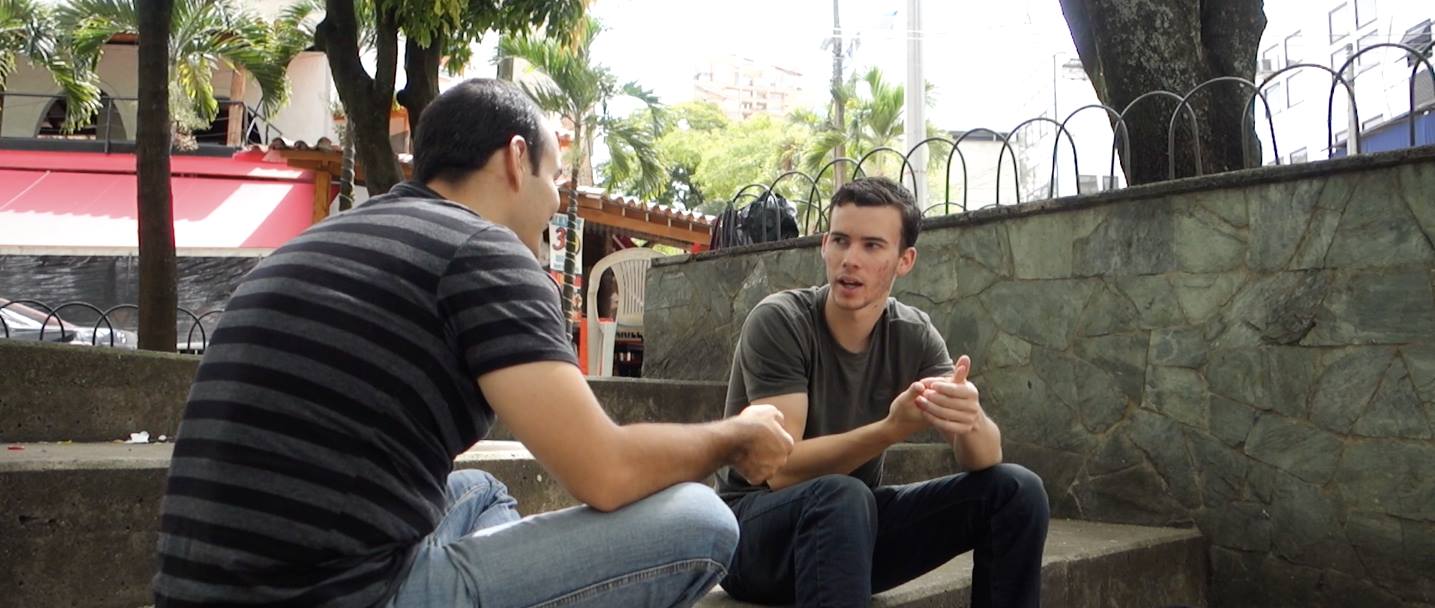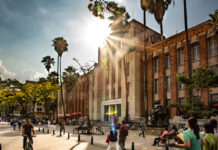Editor’s Note: This is a guest post by Connor Grooms.
11:17 p.m., June 12th, 2015
Subway on Calle 10, Provenza
“Hajidsk, fatskel a dahks uwond que?”
Well, that’s what it sounds like to me, at least.
“Uhhhh…” I stare blankly back at the girl working the late shift. Unfortunately, there’s not much open at this hour, and I’m forced to go to one of the places where I can (barely) point to order some food.
The girl turns to her friend behind the counter and giggles at me. I don’t need Spanish to know that look, “haha, look at this gingro, he’s so hopeless.”
As I leave the shop, somehow with sandwich in hand, I think, “I need to start learning Spanish ASAP.”
Which is precisely what I came to Medellín to do.
–
If you come to Medellín, you will have a very limited experience if you don’t speak at least intermediate Spanish.
Luckily, Medellin is one of the best places in the world to learn it – the accent is clear, they don’t drop different sounds or slur un-intelligible “Spanish” (I’m looking at you, Chile). And because only 4% of the Colombian population speaks English, you won’t get people switching to English with you (a huge challenge in Spain, for example).
I learned Spanish to a functionally conversational level (B1) in a month, starting a few days after my night at Subway. I filmed a documentary, “Spanish in a Month,” about it – which you can watch here:
Here’s how I did it…
Speaking is Everything
Every day from 10 a.m. to 1 p.m., I had one-on-one tutoring with a teacher from Envigado.
I can’t stress how important this is. Software like Duolingo is helpful for the very basics, but beyond that, it’s inefficient and doesn’t include the very thing you are trying to learn how to do: speak.
If you can say and understand something, you can read and write it, but not the other way around.
The teacher is important, as although you will and should practice with taxi drivers, shop keepers, and other normal people in the city, the conversations will be shallow in depth.
So you’ll get lots of practice with the basics, and as soon as you want to have a conversation with some Colombian parceros, you’re struggling.
By having deeper conversations (about things you actually care about) with your teacher, you’ll be comfortable in real, deeper conversations in the street – which is where all the rewards of speaking Spanish are!
Get Your Pronunciation Down Early
Don’t skip this, like most do. Familiarize yourself with the IPA, and train each Spanish sound until it rolls off your tongue as if it was English.
Paisas cringe when I tell them this, but one of the best ways to work on your pronunciation is to listen and sing along to reggaeton – the (usually dirty) Latin hip-hop-influenced music. Because, you know, it’s “seis de la mañana, y todavía no recuerdo nada.”
This is important because it will train your ear to how words are slurred together – because just like English, people don’t speak as things are written (for instance, “what are you doing tonight” sounds like “whadda you doin’ tonight”).
By getting pronunciation down early, you’ll understand and be understood much easier, learn vocab with the correct pronunciation so you can actually recognize it in speech, and blend in more.
There’s nothing sexy about speaking with a thick gringo accent.
Some notes on Paisa pronunciation:
“ll” and “y” are pronounced “j,” not “y.” For example, Medellin is pronounced “Meh-de-JEAN.”
Unlike the coast, the “s” is not dropped at the end of words.
The accent in Medellin is very clear and you shouldn’t have too much trouble after learning the sounds.
Use an SRS
An SRS, or Spaced Repetition System, is a set of smart digital flashcards.
The more you get something right, the longer it is before you see it again, streamlining practice and making sure you are reminded of the word just before you were about to forget it (when recall creates the strongest memory).
I use and recommend Anki for this, but Memrise is another popular solution.
This is the fastest way to drill lots of words and conjugations into your head. Make sure to put English on the front to train recall not recognition.
Make sure to actually use the words you learn in speech as much and soon as possible, as actually using them is still the way to create the strongest memory (and stops you from having to think about what the word is, so the Spanish just comes out like English would).
Speak Like a Paisa
You’re in Medellín, so you may as well be using the local slang!
Here are some of the most common paisa-specific things to say:
– Don’t say “de nada”, say “con gusto”
– Don’t say “adios” (unless it’s goodbye for a long time), say “ciao”
– Don’t say “amigo,” say “parce” or “parcero” (which means dude/mate/bro, basically)
– Add “o que” at the end of anything to make it a question
– Add “pues” at almost any point in any sentence and it will make sense. It literally means “well,” but it’s also used as an “uhhhm”
– Change the end of words to “is,” like “raro – raris, hola – holis” to sound like a (usually) uneducated teenage girl (actually, please don’t)
– Add “que” in front of any adjective used in a reaction. Instead of “chevere,” you’d say, “que chevere”
– Use “bien o no” or “bien o que” with friends instead of “como estas” (which is still heavily used as well)
– Greet good friends with “que mas?” (what’s up?)
– Instead of “si,” use the affirmatives “claro” (of course – this is heavily used), “cierto” (right), or “eso” (literally, “that,” but used as a general affirmative)
I have a phrase I use with my friends to joke about paisa Spanish – “claro que pues.” It means nothing, but after you’ve lived here for a little while, it’ll make you laugh.
So come to Medellín to learn Spanish! Not only is a great place to learn, but it’s an amazing place to live. And if you haven’t seen it yet, watch my documentary about how I learned Spanish in a month.
_________
About the Author: Connor Grooms learned Spanish to a B1 conversational level in a month and made the film, “Spanish in a Month: A Documentary About Language Learning” about it.












This is great, I think your strategy is spot on! I’m a linguist and language teacher myself and I freaking *swear* by the IPA for language learning, so glad to see you’ve mentioned it here. It takes a bit of time to get it down but it’s so rewarding for exactly the reasons you’ve said!
Que chevere que has aprendido tan rapido, felicidades!
Connor, we just finished watching your YouTube…and, wow! It really was encouraging for me, who’ve barely started Spanish and my husband who is in the perfection-sabotaging-communication level (he was an attorney…what more can be said!) We are coming to Medellin for a first look at what may be our expat home and will certainly adopt much of your experiences, should we decide to move to this wonderful city. Thanks for all you do.
Thanks for sharing Connor, and I enjoyed watching the doco.
My only beef is your claim that Paisa Spanish is ‘clear’. I agree that it is not the mush you’ll hear from the average Chilean, nor as difficult as Caribbean Spanish (Cuba or DR for example), but clear is an overstatement.
There is a reason that the US gov’t had such a difficult time infiltrating the cartels in the 1980s; there was a complete disconnect between Paisa slang, culture, and language compared with anything agents had experienced growing up in Mexico or Puerto Rico for example. Colombia is quite far from both of those places, I get it. However, my theory is that geographical and political isolation created an extremely unique culture with extremely unique patterns of speech. As someone who has lived in many different Spanish speaking countries, perhaps my ears haven’t been able to tune out the various accents I have become accustomed to hearing, yet after 6 months here (as a fluent Spanish speaker) there are still numerous instances of having to double and triple take to understand a local.
Just my 2 cents, keep up the good work on the language brotha.
I have to agree that Medellin Spanish is far from a clear strain of Spanish. It’s strongly accented, uses voseo (not to mention usted and tú often all together), and can be practically unintelligible for even experienced Spanish speakers. They also often drop the ‘d’ sound so that “cholado,” for example becomes “cholao.” “Encerrado” will sound like “encarrao” and so on. It’s also spoken quite fast compared to some countries.
Bogota Spanish is much easier to understand, as is Mexican or Peruvian. All of those are neutral and clear versions of Spanish. Medellín not so much.